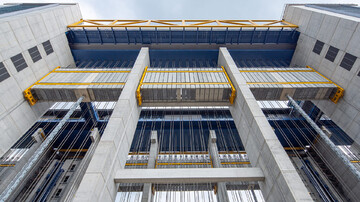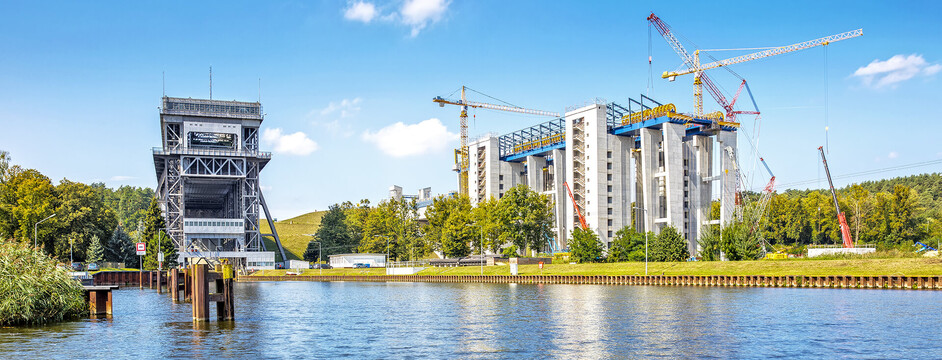
Construction of the new Niederfinow ship’s hoist, electrical engineering
Starting position
In 1914, the Hohenzollern canal (now the Havel-Oder waterway) was opened to shipping for the first time. Due to a lack of experience, a decision was made at that time against a ship's hoist to bridge the 36 m difference in height near Niederfinow between the Oder and the Oder-Havel canal and instead a series of locks was built. This consisted of 4 locks arranged one behind the other, each with a lifting height of 9 m. For 20 years, the locks were the only way to traverse the difference in height of the terrain by ship. Due to the high volume of ships, the waiting times became very long, meaning that the ships had to wait five to six days to pass through the locks. For this reason, in 1927, the construction of a ship's hoist was started, which was inaugurated in 1934. At that time, the ship's hoist was the largest of its kind in the world; today it is the oldest ship's hoist still working in Germany. A complete lock turnaround (retracting, raising/lowering, extending) takes 20 minutes, whereas using the series of locks took several hours. As a result, the series of locks lost their relevance and were decommissioned in 1972 due to their dilapidated state.
The ship's hoist with its 84-metre trough length and 2-metre loading depth is now no longer up to date. Soon, it will also have reached the end of its service life and would have to be closed for a long time to perform the necessary maintenance work. For the above reasons, it is to be replaced by a new construction, which is scheduled to go into operation in 2020 and from 2025 will completely replace the old lift.
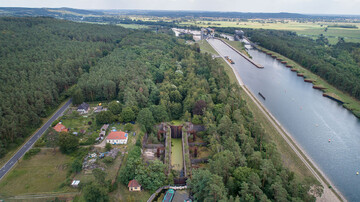
The Task
The "Wasserstraßen Neubauamt Berlin" received the planning order for the new lift as early as in 1992. Thereupon, six building variants and 3 routings were examined. The decision was made in favour of a vertical lift equipped with a counterweight fixed in a reinforced concrete construction, located between the existing lift and the old series of locks. A canal bridge was built to connect the upper outer harbour with the lift. This rests on 28 reinforced concrete piles that are anchored 40 m deep in the ground to carry the 3,300-tonne load.
The construction of the new ship's hoist will benefit Brandenburg as a business location and shift a large part of the goods transported onto the water. In addition, it will also complete the trans-European waterway network so that goods can be transported from Szczecin to the Rhine. The construction will also make it possible to extend the waterway connection from Berlin to the Baltic Sea for goods transport with a ship's draught of up to 2.8 m. The 4-metre water depth in the trough and the increased trough dimensions (usable length: 115 m, usable width: 12.5 m) means that the new ship's hoist will allow ships up to 110 metres in length with 2-layer rows of containers to be lifted.
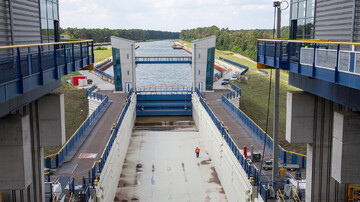
Services
To protect the trough from damage, a cable barrier with a brake cylinder on one side is used as shock protection. The trough drive is comprised of 8 motors, each with its own frequency converter, and is attached to the trough as are other system components. Therefore, the low voltage distribution had to be planned with the exception of the trough. Electrical rooms were provided to set up the switchgear for the electrical equipment and to position the frequency converters for the drive motors for the trough. In addition to the requisite low-voltage distribution system, a medium-voltage system was also planned and all the necessary overview plans prepared. The hoist and drives are controlled over programmable logic controllers. We were responsible here among other things for performing the software test to check whether all the necessary functions were available and working correctly.
We planned the operation over a redundant operating and monitoring system from a central control station, as we did the on-site operating stations for the gates, machines and drives in order to be optimally equipped for emergencies. We also planned in a UPS system to ensure that all the control and communications equipment can continue to operate in the event of a power failure. This ensures that communication with the ship is possible at all times over the camera and communication systems. Furthermore, an intercom and loudspeaker system was incorporated. The latter is used to announce information to visitors to the ship's hoist.
A further part of our assignment included the planning and design of the lightning protection, earthing and equipotential bonding systems, as well as consideration of surge protection devices for all electrical and electrotechnical systems. In addition, measuring and recording systems, light signalling systems and level measuring equipment were planned in. We also performed a lighting calculation for the safety lighting and the interior and exterior lighting systems. We designed the telephone system and the transmitting and receiving system for the Nautical Information Radio (NIR) as well.
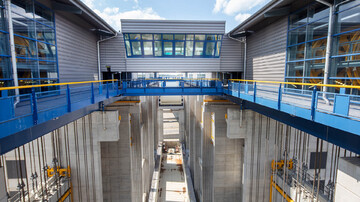
Challenges and special features
The old ship's hoist was awarded the title of "Historic Landmark of Civil Engineering in Germany" by the Federal Chamber of Engineers in 2007 and attracts around 150,000 visitors a year. The construction of the new ship's hoist lift caused the number of visitors to continue to rise, which is why an information centre was opened for visitors in 2019. Of particular interest to visitors is the technical sequence of events, which is why visitors can see the technology of the new ship's hoist behind glass.
The sophisticated technology of the existing ship's hoist was adopted for the new ship's hoist. The water-filled trough always weighs the same because a ship displaces as much water as it weighs itself. The counterweights balance the load fully so that the drives only need to apply the force required to overcome the friction, start-up forces and small differences in water level.
Chinese engineers were so impressed by the technology used that they used the same technology for the ship's hoist at the Three Gorges Dam. This lift, the electrical system of which was also planned by our engineers, has been in operation since 2016. Together with our customers, we were awarded the Ulrich Finsterwalder Civil Engineering Prize (Verlag Ernst und Sohn) in 2017 for the ship's hoist at the Three Gorges Dam.
